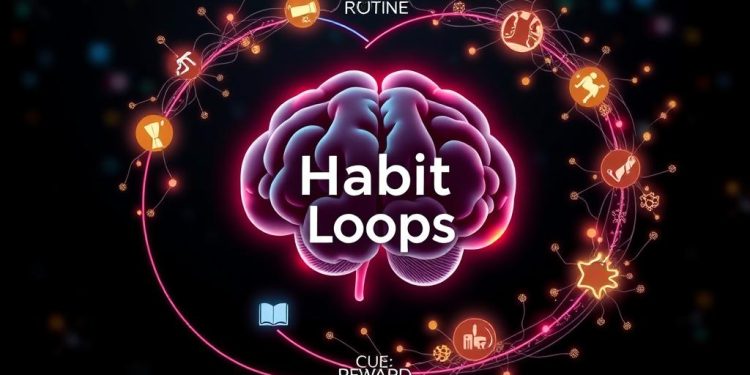Understanding the triggers and rewards in habit formation is essential for making meaningful changes in your daily life. Research indicates that 40% of our daily actions are habit-driven, highlighting the significant impact of habits on our behaviors. The habit loop, consisting of cue, craving, response, and reward, is a key concept in behavior psychology, as detailed by experts like James Clear in his book “Atomic Habits.” When you grasp how these elements interconnect, you can leverage them to initiate effective behavioral transformations.
Every day, you experience numerous habitual actions triggered by specific cues, such as waking up—a time when you might follow a predictable sequence of tasks like brushing your teeth or making coffee. Acknowledging these habit loops can motivate you to build or replace habits, particularly by understanding the importance of positive reinforcement. Consistently implementing positive reinforcement can increase the likelihood of establishing and maintaining these habits. Throughout this article, we will delve into the dynamics of triggers and rewards, providing you with actionable insights for successful habit formation.
Understanding Habits: The Habit Loop
To grasp how habits form, it is essential to understand the habit loop, a framework that encapsulates the essential components driving behavior. The habit loop consists of three primary elements: the cue, the routine, and the reward. Each component interacts and reinforces your habit motivation, making it crucial to recognize their roles in habit formation.
Components of the Habit Loop
The habit loop begins with a cue, which acts as the trigger that initiates the behavior. For instance, a specific time of day or an emotional state can serve as an effective cue. Following the cue, you engage in a routine, which represents the behavior you perform in response to that cue. Finally, the cycle concludes with a reward, the benefit gained from completing the routine. Immediate rewards strengthen your desire to engage in that behavior again, reinforcing the loop.
The Importance of Each Phase
Each phase of the habit loop plays a significant role in determining the effectiveness of habit formation. Understanding these components allows you to create strategies for improving your habits.
- Cue: Clear and specific cues increase the likelihood of initiating the desired action.
- Routine: This is the behavior or action taken when the cue is recognized. Make it easy to follow.
- Reward: Providing instant gratification can enhance habit completion and encourage repetition.
By identifying where changes can be made within the habit loop, you can foster positive habits and diminish negative ones. Charles Duhigg’s research highlights how the more often a habit loop is activated, the more ingrained the habit becomes over time. The connection between each component frames your ability to adapt and develop effective habits.
| Component | Description | Importance |
|---|---|---|
| Cue | The trigger that initiates the habit loop. | Sets the stage for the routine, essential in forming habits. |
| Routine | The behavior performed in response to the cue. | The action solidifies the habit and builds consistency. |
| Reward | The benefit gained from completing the routine. | Reinforces the behavior, increasing the likelihood of repetition. |
Understanding the nuances of the habit loop fosters an environment conducive to forming lasting habits, empowering you to navigate your daily choices more effectively.
Triggers: The Starting Point for New Habits
Understanding the role of habit triggers is essential for creating effective routines. Triggers serve as the entry point for behaviors, initiating actions that can lead to the formation of new habits. Recognizing the types of habit cues can significantly enhance the likelihood of successfully integrating positive changes into your life.
The Five Main Types of Habit Cues
There are five primary types of habit cues that can prompt behaviors:
- Time: Habits often form around specific times of the day, like making your morning coffee.
- Location: Certain actions may be triggered by your surroundings, such as visiting the kitchen when you’re hungry.
- Preceding Events: Actions can be ignited by previous activities, such as replying to a text after receiving it.
- Emotional States: Feelings can lead to habits, either reinforcing positive behaviors or instigating negative ones.
- Other People: Social interactions can serve as triggers by influencing behaviors learned from those around you.
How to Identify Effective Triggers
Discovering effective triggers tailored to your lifestyle can significantly strengthen your ability to form new habits. Consider these strategies to identify which habit cues resonate best with you:
- Keep a journal to track when and where you engage in specific routines.
- Observe your emotional responses around various activities to determine what feelings prompt certain behaviors.
- Experiment with different social settings to assess how they influence your habits.
- Establish consistent times for activities to create reliable routines.
- Reflect on past behaviors to find patterns in your habit formation.
Understanding these elements can empower you to take charge of your routines. Habit triggers not only influence your actions but also play a crucial role in long-term habit formation, making it vital to identify and utilize effective triggers that suit your lifestyle.
Rewards: The Motivation Behind Habit Formation
Understanding the role of rewards in habit formation can significantly enhance your ability to cultivate lasting behaviors. Rewards serve as a motivational force that reinforces the desire to repeat specific actions. Successfully integrating reward systems can lead to improved personal success and self-improvement in various aspects of life.
Types of Rewards That Reinforce Habits
Numerous types of rewards exist that can effectively support habit development. These can be categorized as follows:
- Tangible Rewards: Items or experiences that provide physical gratification, such as a favorite snack after a workout.
- Emotional Satisfaction: Rewards linked with feelings of happiness, such as a sense of accomplishment from completing a goal.
- Personal Growth Recognition: Acknowledgment of progress and development, promoting a positive self-image.
Each of these reward types plays a critical role in making habits more appealing, encouraging their repetition over time. Recognizing the various types of rewards can help you choose the ones that resonate most with your personal motivations and goals.
The Role of Positive Reinforcement in Behavior Psychology
Positive reinforcement is a fundamental concept in behavior psychology that influences habit formation. This process involves providing a satisfying outcome following a desired behavior, leading to increased likelihood of that behavior being repeated. For example, when you experience the joy of completing a workout, it reinforces that behavior, making it more likely you’ll exercise again in the future.
Dopamine is a key player in this process, released in anticipation of a reward and significantly influencing the habit loop. Understanding how to utilize positive reinforcement effectively can help you establish a robust framework for your habits, even in the face of challenges or high limbic friction that might otherwise deter you.
Implementing micro-celebrations to recognize small successes can further boost dopamine release, reinforcing new behaviors and solidifying their place within your routine. Ultimately, by prioritizing effective reward systems and applying principles of positive reinforcement, you can empower yourself to stick to new habits and achieve your personal goals.
Triggers and Rewards in Habit Formation
Understanding the relationship between triggers and rewards is essential for effective habit formation. Triggers serve as cues that spark cravings, which motivate behavior. This sequence is crucial in establishing habit loops that foster long-term change. By appreciating this connection, you can create effective cycles promoting your desired habits.
The Connection Between Cues and Cravings
Research highlights that cravings play a pivotal role in the habit loop. When a specific trigger activates a craving, it signals the brain to initiate a behavior, leading to a reward. For instance, upon seeing a running shoe, you might feel a craving to run, driving you to lace up and head out. This connection strengthens with repetition, making the behavior more automatic over time. Neuroscientists from MIT have identified neurons that activate during these moments, illustrating how our brain recognizes this crucial link.
Creating Habit Loops for Long-Term Change
To build effective habit loops, focus on three essential components: the cue (trigger), the routine (behavior), and the reward. You can identify obvious cues and pair them with enjoyable rewards to satisfy your cravings. Using tangible rewards may further increase your motivation compared to intrinsic rewards alone. Consider using the MindLabs app for daily reminders to reinforce your routines. As you continue this cycle, the repetition strengthens neural pathways, making the behavior increasingly automatic. Eventually, these habit loops lead to sustained change, reducing decision fatigue and enhancing your overall mental clarity.
| Component | Description | Example |
|---|---|---|
| Cue (Trigger) | A specific signal prompting action | Seeing workout gear |
| Routine (Behavior) | The action taken in response to the cue | Going for a run |
| Reward | Positive outcome following the routine | Feeling accomplished and energized |
By consistently implementing this structure, you can create sustainable habit loops that lead to significant long-term change in your life.
Using External Factors: The Role of Environment and People
Your environment plays a crucial role in shaping the habits you form. Location triggers often prompt specific behaviors, making it essential to be mindful of your surroundings. For instance, entering a kitchen can trigger snack cravings, while a gym encourages an exercise mindset. Cultivating an environment that aligns with your goals can significantly influence your habit formation.
Location as a Trigger
Location triggers can greatly enhance or hinder habit formation. When you think about where your habits occur, consider the following:
- Being in a gym promotes physical activity.
- A well-stocked, healthy kitchen encourages nutritious eating.
- Having a dedicated workspace can boost productivity.
Research indicates that approximately 65% of individuals believe their physical environment influences their food choices. Creating a setting that actively promotes desired habits can lead to automatic, thoughtless actions over time. The average time to form a habit is around 66 days, establishing a repetitive connection between location and behavior.
The Influence of Social Circles on Habits
Your social circles can significantly impact your habits. Engaging with supportive peers who encourage positive behaviors makes success more attainable. Studies show individuals with strong social connections are 70% more likely to adhere to health routines compared to those without such support.
Consider these key points when evaluating the influence of your social environment:
- People who celebrate small wins tend to maintain their routines, with 75% of successful habit changers highlighting this motivator.
- Those who set SMART goals are 50% more likely to achieve their objectives.
- Acknowledging setbacks and adjusting is crucial; 60% of individuals report that doing so assists in continuing towards their goals.
Recognizing that external factors like your environment and social circles shape your habits enables you to better understand and leverage them for lasting behavior change.
| External Factors | Impact on Habits |
|---|---|
| Location Triggers | Prompts specific behaviors automatically over time |
| Supportive Social Circles | Increase likelihood of sticking to health routines by 70% |
| Visible Cues | Encourages consistent behaviors, such as workout schedules |
| Celebration of Wins | Motivates individuals to maintain routines and overcome challenges |
Strategies for Building Effective Habits
Building effective habits involves strategic planning to enhance your daily routines. The process begins with replacing bad habits with good ones, creating a foundation for lasting change. By identifying the triggers and motivations that lead to undesirable behaviors, you can successfully transition to healthier alternatives. This method nurtures a smoother pathway to achieving your goals.
Replacing Bad Habits with Good Ones
Replacing bad habits is essential for personal growth. Start by recognizing the habits that no longer serve you. Here are some steps to guide your journey:
- Identify your bad habits and the triggers that lead to them.
- Choose a desirable habit to replace each unwanted one.
- Utilize positive reinforcement to enhance the experience.
- Be patient and consistent, as habit formation takes time.
Employing these techniques promotes resilience against the pull of old habits and aids in building effective habits. Remember to align these changes with your broader goals for better motivation.
Habit Stacking: Combining New Habits with Existing Ones
Habit stacking is an effective technique where you tie a new habit to one that already exists in your routine. This method leverages the established habit loop, making the integration of new behaviors seamless. Here’s how to implement habit stacking:
- Identify a strong existing habit.
- Decide on a new habit you want to adopt.
- Plan to perform the new habit immediately after completing the existing one.
For example, if you already have a routine of morning coffee, you might stack a healthy habit such as drinking a glass of water right after. This approach simplifies the process of building effective habits and ultimately leads to consistent change over time.
Conclusion
Understanding the role of triggers and rewards is vital for successful habit formation. Duhigg’s habit loop, comprising cue, routine, and reward, offers a structured process that highlights how your brain engages with new behaviors. Recognizing these components will empower you to identify effective triggers and implement reinforcement strategies, setting the stage for lasting behavior change in your life.
The intricate connection between cues and cravings emerges as a significant factor in your journey. Research suggests that once a cue is established, and a routine consistently follows with an anticipated reward, a craving begins to solidify the habit loop in your mind. This demonstrates how anticipation can produce brain activity comparable to the reward itself, reinforcing the importance of reward mechanisms in forming habits.
Incorporating environmental and social influences can enhance your efforts further. As you move through this journey of habit formation, it’s essential to remain intentional about applying these insights. By leveraging the strategies of triggers, routine, and reward, you can foster impactful behavior change that aligns with your personal goals, ultimately leading to a more fulfilling and productive life.









